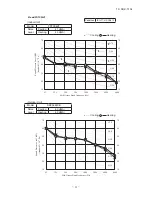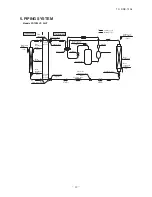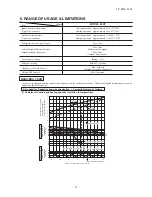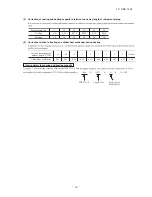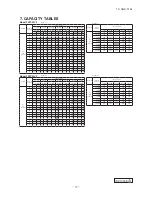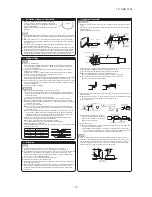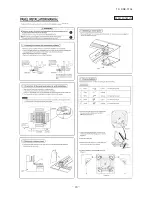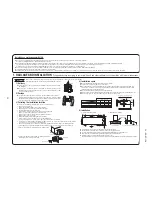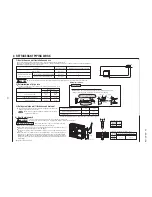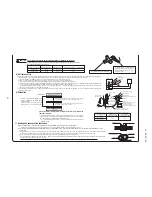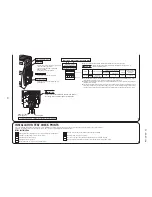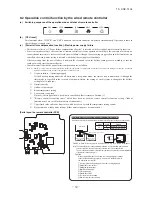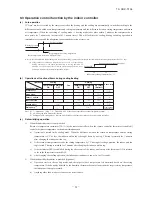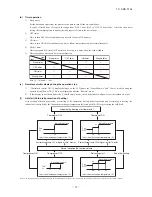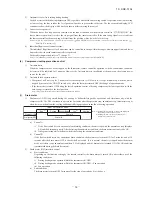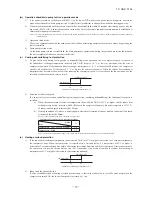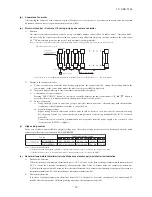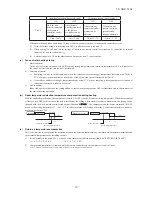
-
25
-
'12 • SRK-T
-126
'09•SRK-DB-087D
2. REFRIGERANT PIPING WORK
1) Restrictions on unit installation and use
●
Check the following points in light of the indoor unit specifications and the installation site.
●
Observe the following restrictions on unit installation and use. Improper installation can result in a compressor failure or performance degradation.
●
Additional refrigerant charge is not required at all.
2) Determination of pipe size
●
Determine refrigerant pipe size pursuant to the following guidelines based on the
indoor unit specifications.
15m or less
10m or less
10m or less
L
H
H
e
p
i
p
s
a
G
Liquid pipe
Ǿ
9.52
Ǿ
6.35
Flare
Flare
Ǿ
9.52
Ǿ
6.35
Ǿ
9.52
Ǿ
6.35
L
H
Outdoor unit
Indoor unit
CAUTION
●
The use restrictions appearing in the table above are applicable to the standard pipe size combinations shown in the table below.
Restrictions
Dimensional restrictions
Marks appearing in the drawing on the right
Main pipe length
When the outdoor unit is positioned higher,
When the outdoor unit is positioned lower,
Elevation difference between
indoor and outdoor units
Outdoor unit connected
Refrigerant piping (branch pipeL)
Indoor unit connected
Plug the end of the pipe with tape, or other
material, and fill the pipe with nitrogen gas.
Only use nitrogen gas (N
2
)
Taping
<
N
2
>
Nitrogen
Brazing
Station valve
Primary side
Secondary side
0.5MPa
Hand
Relief valve
Nitrogen
gas
Brazing must be performed under a nitrogen gas flow.
Without nitrogen gas, a large quantity of foreign matters (oxidized film) are created,
causing a critical failure from capillary tube or expansion valve clogging.
About brazing
When pipe is brazing.
3) Refrigerant pipe wall thickness and material
●
Select refrigerant pipes of the table shown on the right wall thickness and
material as specified for each pipe size.
Pipe diameter [mm]
Minimum pipe wall thickness [mm]
Pipe material*
6.35
0.8
O-type pipe
9.52
0.8
O-type pipe
NOTE
*Phosphorus deoxidized seamless copper pipe ICS 23.040.15, ICS 77.150.30
●
Select pipes having a wall thickness larger than the specified
minimum pipe thickness.
Model 20, 25, 35
Take care so that installed pipes may not touch components within a unit.
If touching with an internal component, it will generate abnormal sounds and/or vibrations.
4) On-site piping work
IMPORTANT
How to remove the side cover
●
Carry out the on site piping work with the operation valve fully closed.
●
Give sufficient protection to a pipe end (compressed and blazed, or with an adhesive tape) so
that water or foreign matters may not enter the piping.
●
Bend a pipe to a radius as large as practical.(R100
〜
R150) Do not bend a pipe repeatedly to correct
its form.
●
Flare connection is used between the unit and refrigerant pipe. Flare a pipe after engaging a
flare nut onto it. Flare dimensions for R410A are different from those for conventional R407C.
Although we recommend the use of flaring tools designed specifically for R410A, conventional
flaring tools can also be used by adjusting the measurement of protrusion B with a protrusion
control gauge.
●
Tighten a flare joint securely.
Please remove the screw of a side cover and remove to the front.
A
B
Flared pipe end : A
(mm)
Ǿ
6.35
Ǿ
9.52
Copper
pipe outer
diameter
0
ー
0
.
4
A
9
.
1
13.2
Copper pipe protrusion for flaring : B
(mm)
Ǿ
6.35
Ǿ
9.52
Copper
pipe outer
diameter
In the case of a rigid (clutch) type
With an R410A tool With a conventional tool
0
〜
0.5
1.0
〜
1.5
Screw
Side cover

